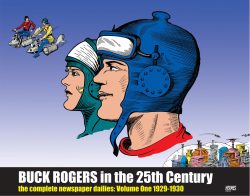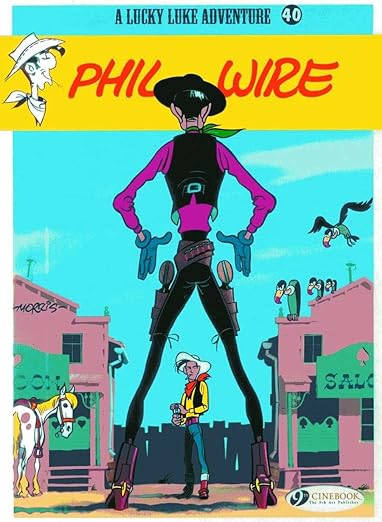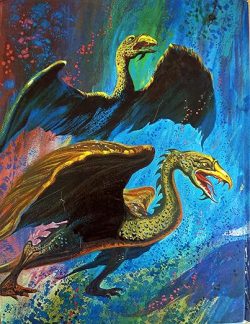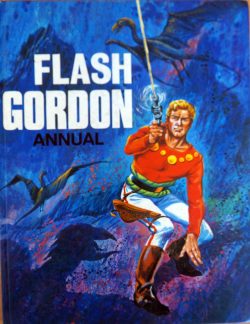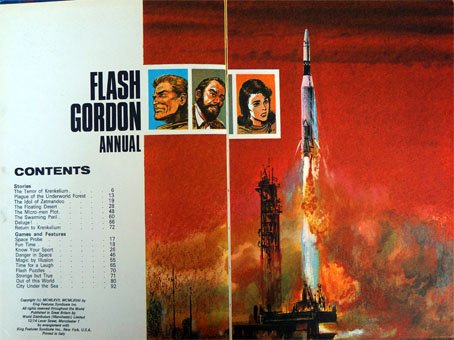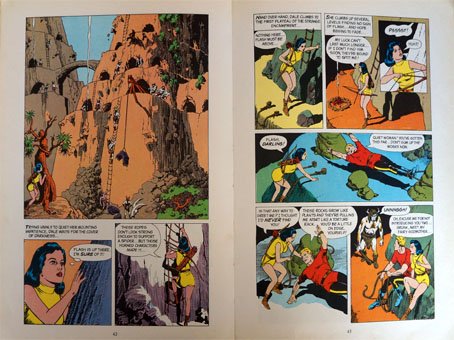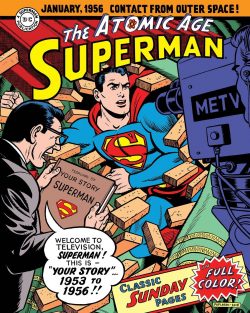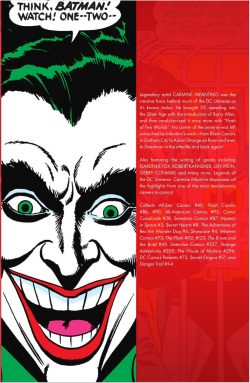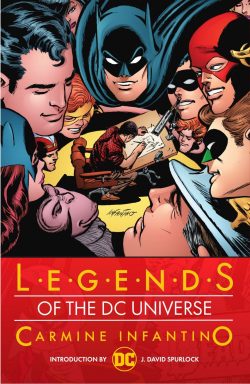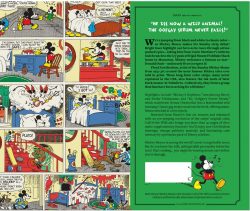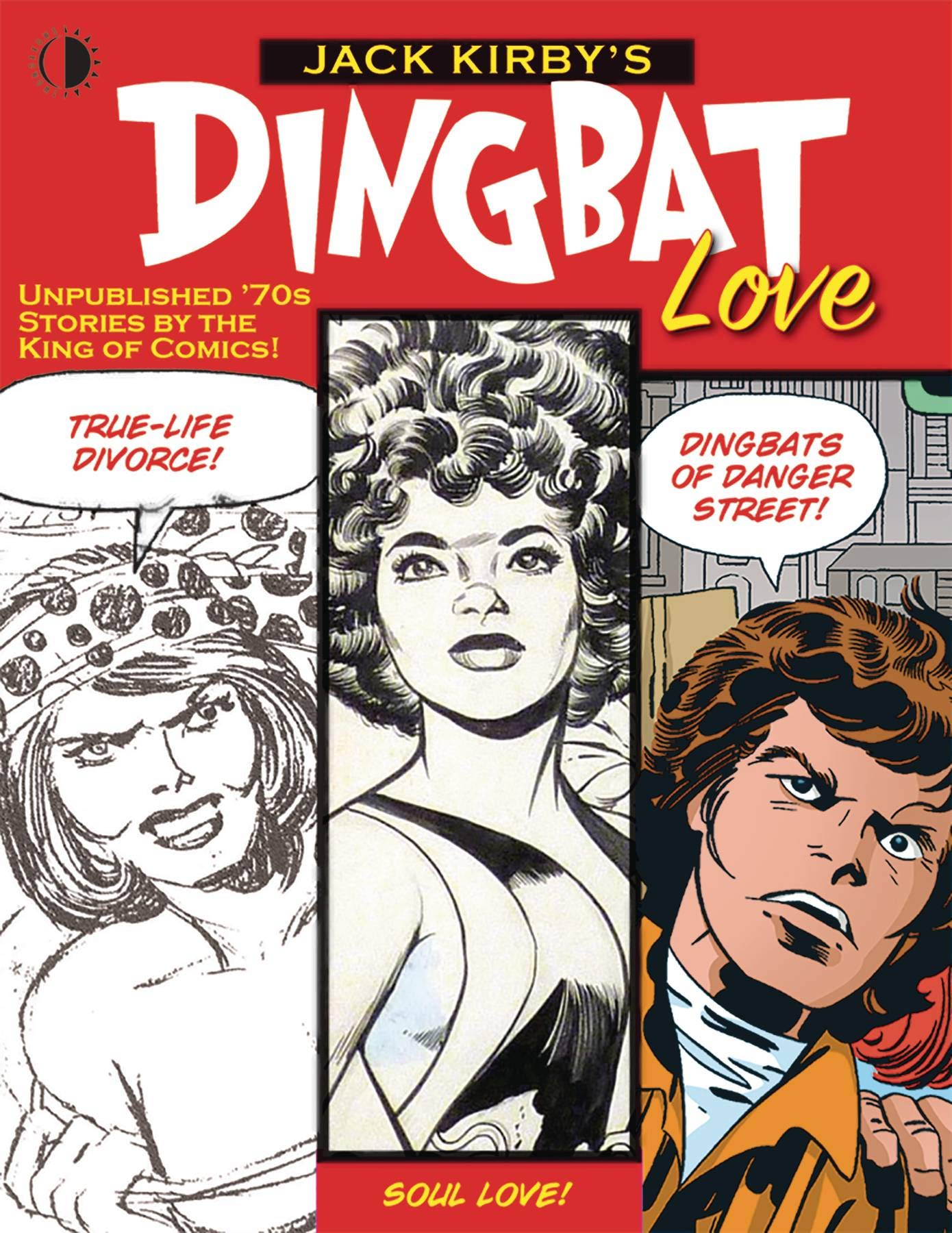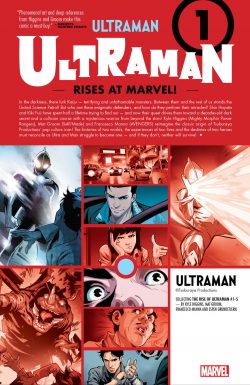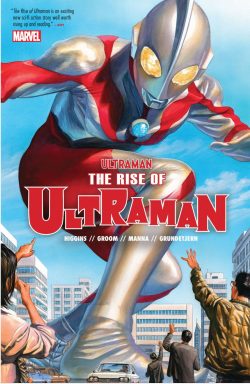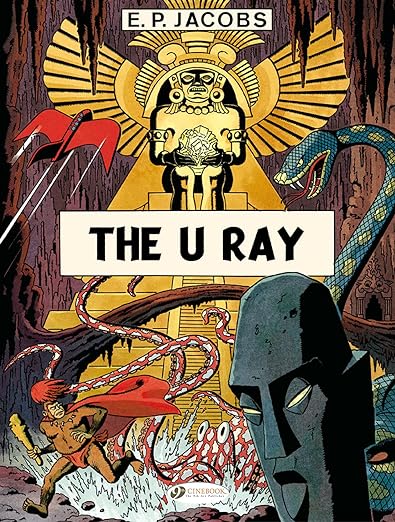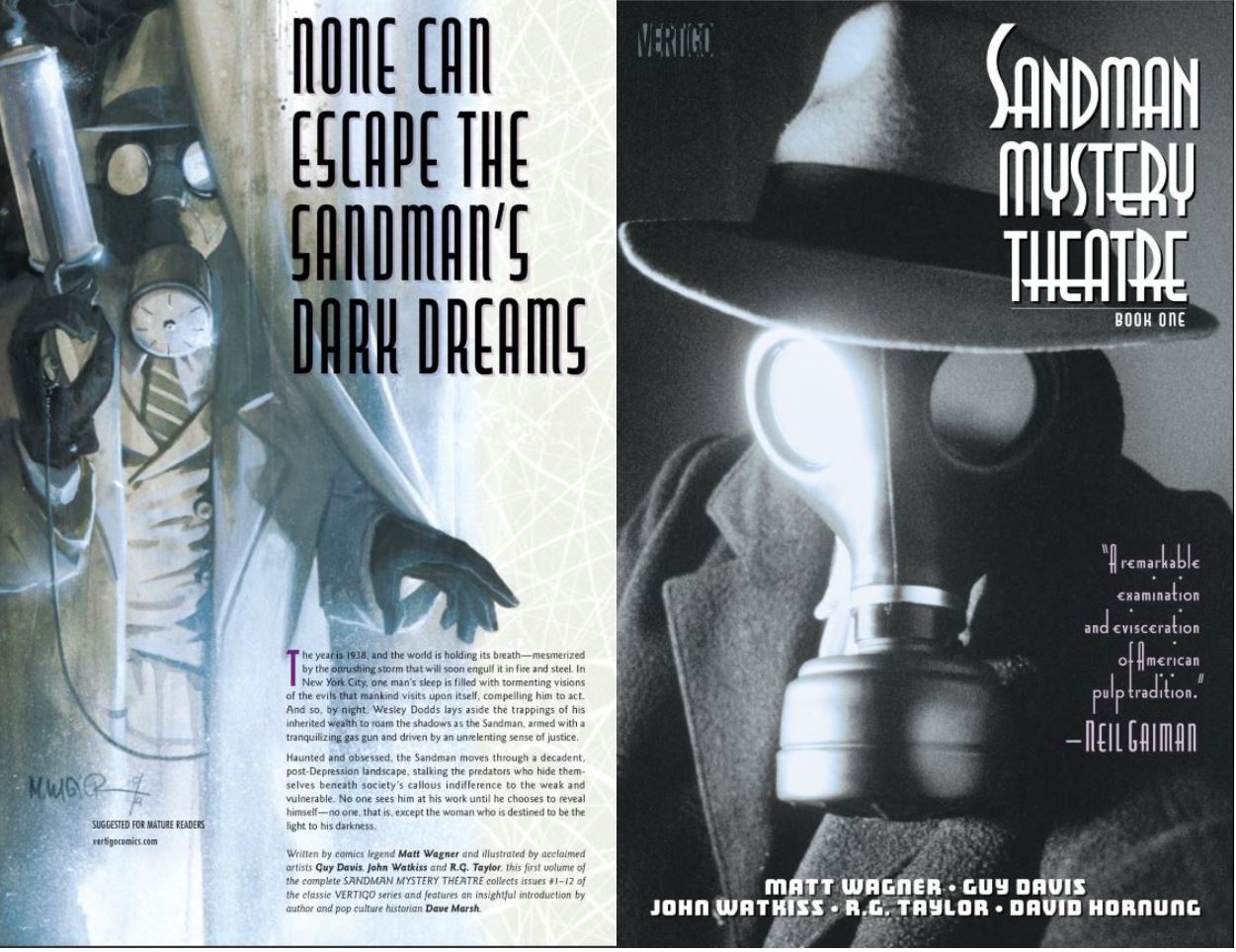
By Matt Wagner, Guy Davis, John Watkiss, R.G. Taylor, David Hornung & John Costanza & various (Vertigo)
ISBN: 978-1-4012-6327-0 (TPB/Digital edition)
Created by Bert Christman & Gardner F. Fox, The Sandman premiered in either Adventure Comics #40 July 1939 (two months after Batman debuted in Detective Comics #27) or two weeks earlier in New York World’s Fair Comics 1939, depending on which rather spotty distribution records can be believed.
Head and face utterly obscured by a gasmask and slouch hat; caped, business-suited millionaire adventurer Wesley Dodds was cut from the iconic masked mystery-man mould that had made pulp fictioneers The Lone Ranger, Green Hornet, The Shadow, The Spider and many more household names. Those dark red-handed heroes were also astonishing commercial successes in the early days of mass periodical publication…
Wielding a sleep-gas gun and haunting the night to battle a string of killers, crooks and spies, he was accompanied in the earliest comicbooks by his plucky paramour Dian Belmont, before gradually losing the readers’ interest and slipping from cover-spot to last feature in Adventure Comics, just as the cloaked pulp-hero avengers he emulated slipped from popularity in favour of more flamboyant fictional fare.
Possessing a certain indefinable style and charm but definitely no especial pizzazz, the feature was on the verge of being dropped when the Sandman abruptly switched to skin-tight yellow-&-purple and gained boy-sidekick Sandy the Golden Boy (Adventure Comics #69, December 1941, courtesy of Mort Weisinger & Paul Norris). All this, presumably to emulate the overwhelmingly successful Batman and Captain America models then reaping big dividends on newsstands.
It didn’t help much, but when Joe Simon & Jack Kirby came aboard with #72 it all changed. A semi-supernatural element and fascination with the world of dreams (revisited by S&K a decade later in their short-lived experimental suspense series The Strange World of Your Dreams) added moody conceptual punch to balance the kinetic fury of their art, as Sandman and Sandy became literally the stuff of nightmares to bizarre bandits and murderous mugs…
For what happened next you can check out the superb Simon & Kirby Sandman collection.
Time passed and in the late 1980s Neil Gaiman, Sam Keith & Mike Dringenberg took the property in a revolutionary new direction, eventually linking all the previous reboot elements into an overarching connective continuity under DC’s new “sophisticated suspense” imprint Vertigo. Within a few years the astounding success of the new Sandman prompted editorial powers-that-be to revisit the stylishly retro original character and look at him through more mature eyes. Iconoclastic creator Matt Wagner (Mage, Grendel, The Demon, Batman) teamed with artistic adept Guy Davis (Baker Street, B.P.R.D.) and colourist David Hornung to channel a grittier, grimier, far more viscerally authentic 1930s, where the haunted mystery man could pursue his lonely crusade with chilling verisimilitude.
The tone was darkly modernistic, with crime-busting played out in the dissolute dog-days of the Jazz Age and addressing controversial themes such as abuse, sexual depravity, corruption and racism; all presented against the rising tide of fascism sweeping the world then.
Consider this a warning: Sandman Mystery Theatre is not for kids.
This compendium collects the first three redefining story-arcs from issues #1-12 (April 1993 to March 1994) and commences after an absorbing introduction from veteran journalist, critic and pop culture historian Dave Marsh.
Each chapter preceded by its original evocative faux pulp photo cover created by Gavin Wilson and Hornung, the dark drama opens with The Tarantula, taking us to New York in 1938 where District Attorney Larry Belmont is having the Devil’s own time keeping his wild-child daughter out of trouble and out of the newspapers. Dian is gallivanting all over town every night with her spoiled rich friends: drinking, partying and associating with all the wrong people, but the prominent public servant has far larger problems too. One is a mysterious gas-masked figure he finds rifling his safe soon after Dian departs…
The intruder easily overpowers the DA with some kind of sleeping gas – which also makes you want to blurt every inconvenient truth – before disappearing, leaving Belmont to awaken with a headache and wondering if it was all a dream…
After a rowdy night carousing with scandalous BFF Catherine Van Der Meer and her latest (gangster) lover, Dian gets up with a similar hangover, but still agrees to attend one of father’s dreary public functions that evening. The elder Belmont is particularly keen that she meet a studious young man named Wesley Dodds, recently returned from years in the Orient to take over his deceased dad’s many business interests. Dodds seems genteel and effete, yet Dian finds there’s something oddly compelling about him. Moreover, he too seems to feel a connection…
The Gala breaks up early when the DA is informed of a sensational crime. Catherine Van Der Meer has been kidnapped by someone calling himself as The Tarantula…
Across town, mob boss Albert Goldman meets with fellow gangsters from the West Coast and, as usual, his useless son Roger and drunken wife Miriam embarrass him. Daughter Celia is the only one he can depend on these days, but even her unwavering devotion seems increasingly divided. After another stormy scene, the conference ends early, and the visiting crimelords are appalled to find their usually diligent bodyguards soundly asleep in their limousines…
Even with Catherine kidnapped, Dian is determined to go out that night, but when Wesley arrives unexpectedly changes her mind, much to her father’s relief. The feeling doesn’t last long, however, after the police inform him the Tarantula has taken another woman…
When a hideously mutilated body is found, Dian inveigles herself into accompanying dear old Dad to Headquarters but is promptly excluded from the grisly “Man’s Business”. Left alone, she starts snooping in the offices and encounters a bizarre gas-masked figure poring through files. Before she can react, he dashes past her and escapes, leaving her to explain to the assorted useless lawmen cluttering up the place.
Furious and humiliated, Dian then insists that she officially identify Catherine and nobody can dissuade her. Shockingly, the savagely ruined body is not her best friend but yet another victim. Somewhere dark and hidden, Van Der Meer is being tortured, but the perpetrator has far more than macabre gratification in mind…
In the Goldman house, Celia is daily extending her control over darling devoted Daddy. They still share a very special secret, but these days she’s the one dictating where and when they indulge themselves…
With all the trauma in her life, Dian increasingly finds Wesley a comforting rock, but perhaps that view would change if she knew how he spends his nights. Dodds is tormented, plagued by bad dreams. Not his own nightmares, but rather somnolent screams of nameless victims and their cruel oppressors haunt his troubled slumbers. Worst of all, these dreams are unrelenting and somehow prophetic. What else can a decent man do then, but act to end such suffering?
In a seedy dive, uncompromising Police Lieutenant Burke comes off worst when he discovers the gas-mask lunatic grilling a suspect in “his” kidnapping case and again later when this “Sandman” is found at a factory where the vehicle used to transport victims is hidden.
Even so, the net is inexorably tightening on both Tarantula and the vigilante interfering in the investigation, but Burke doesn’t know who he most wants in his nice, dark interrogation room…
As the labyrinthine web of mystery and monstrosity unravels, tension mounts and the death toll climbs, but can The Sandman stop the torrent of depraved terror before the determined Dian finds herself swept up in all the blood and death?
Of course, he does but not without appalling consequences…
Scene and scenario suitably set, John Watkiss steps in to illuminate second saga The Face (issues #5-8). Attention switches to Chinatown in February of 1938, where Dian and her gal-pals scandalously dine and dish dirt… until Miss Belmont meets again an old lover.
Jimmy Shan once worked in her father’s office but now serves as lawyer and fixer for his own people amongst the teeming restaurants, gambling dens and bordellos of the oriental district. Dian would be horrified to see Jimmy – or Zhang Chai Lao as his Tong masters know him – consorting with unsavoury criminals, and would certainly not be considering reviving her scandalous out-of-hours relationship with him. All such frivolous thoughts vanish, however, when the diners vacate the restaurant and stumble upon a severed head: a warning that the ruling factions are about to go to war again in Chinatown. As usual, white police are utterly ineffectual against the closed ranks of the enclave…
Later at a swanky charity soiree to raise money for a school, Dian meets Jimmy again and agrees to a meeting. At the same shindig she later sees Wesley, and in the course of their small talk, Dodds reveals that he recognises Shan from somewhere.
…And in Chinatown, another beheading leads to greater tension between the Lee Feng and Hou Yibai Societies. When an enigmatic gas-masked stranger starts asking unavoidable questions, he finds both Tongs denying all knowledge of the killings…
As the grisly murder-toll mounts, The Sandman’s investigations lead to one inescapable conclusion: a third party is responsible. But who, and why? Before this drama closes, Dian will learn more hard truths about the world and the money-men who secretly run it…
Issues #9-12 (December 1993-March 1994) are illustrated by R.G. Taylor, plumbing the darkest depths of human depravity in the tale of ‘The Brute’. The friendship of Dian and Wesley slowly deepens and life seems less fraught in the city, but that ends as a hulking degenerate stalks the back-alleys, killing and brutalising prostitutes and their clients…
Dodds is also on the mind of boxing promoter and businessman Arthur Reisling who’s looking for a fresh financial partner in his global exploitations. The effete-seeming scholar is hard to convince, though, unlike Eddie Ramsey. He’s a poverty-stricken pugilist and single parent desperate to make enough money to pay for his daughter Emily’s TB medicine. Riesling’s offer to him is just as scurrilous but the broken-down pug doesn’t have the luxury of saying “no”…
Eventually, with Dian in tow, Wesley accepts a party invitation from the speculator and meets his dynasty of worthless, over-privileged children. None of them seem right or well-adjusted. Later, when Eddie tries to come clean by informing the authorities of Riesling’s illegal fight events, he’s attacked by the promoter’s thugs and saved by The Sandman – at least until the colossal mystery killer attacks them both and they’re forced to flee for their lives…
As Dodds returns home to recuperate, the punishing dreams escalate to mind-rending intensity. Eddie, meanwhile, is left with no safe option and takes to the streets with Emily. His decision will lead to revolting horror, total tragedy and utter heartbreak.
The Sandman returns to his covert surveillance, silently unearthing the depths of Reisling’s underworld activities and coincidentally exposing a turbulent, dysfunctional atmosphere in the magnate’s home life to match his criminal activities. In this house, corruption of every kind runs deep and wide, and the masked avenger decides it’s time to bring his findings to Dian’s father. This time, District Attorney Belmont is prepared to listen and to act…
As murders mount and Dodds’ dreams escalate in intensity, the strands of a bloody tapestry knot together and the appalling secret of the bestial killer’s connection to Reisling is exposed; only a detonation of expiating violence can restore order…
Stark, compelling and ferociously absorbing, these bleak thrillers depict a cruel but incisive assessment of good and evil no devotee of dark drama should miss, with the period perils accompanied by a gallery of the series’ original, groundbreaking comic book photo-covers and posters by Gavin Wilson, plus later collection covers and related art from Matt Wagner, Alex Toth and Kent Wilson.
© 1993, 1994, 1995, 2016 DC Comics. All Rights Reserved.


